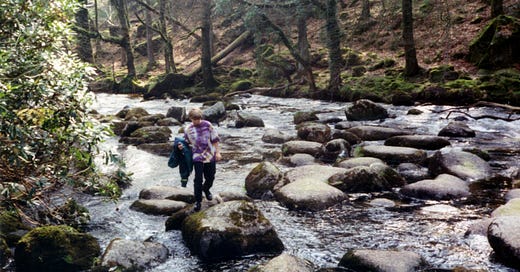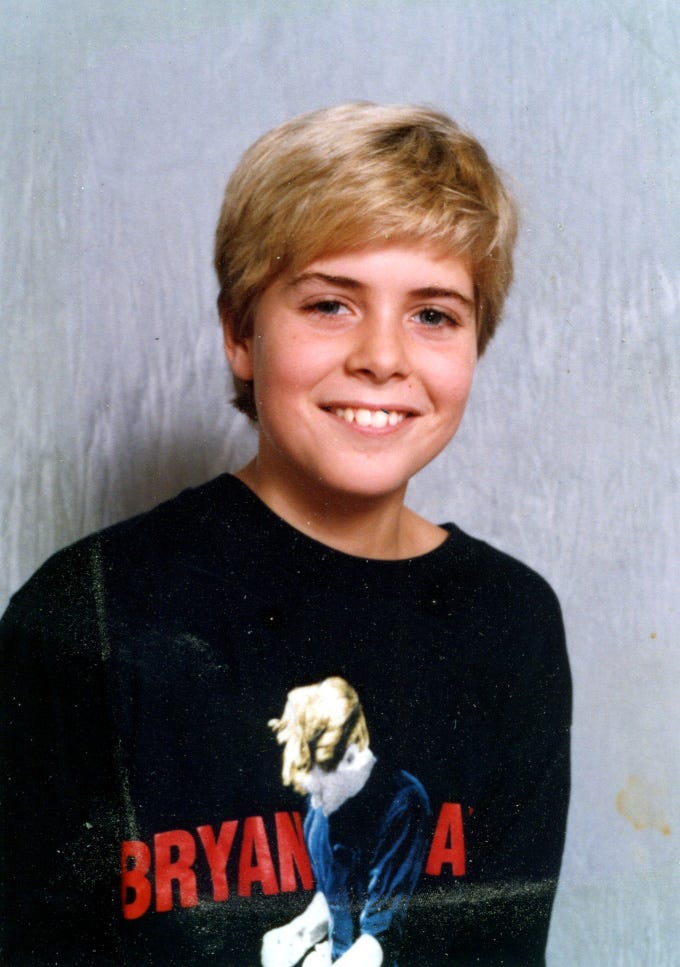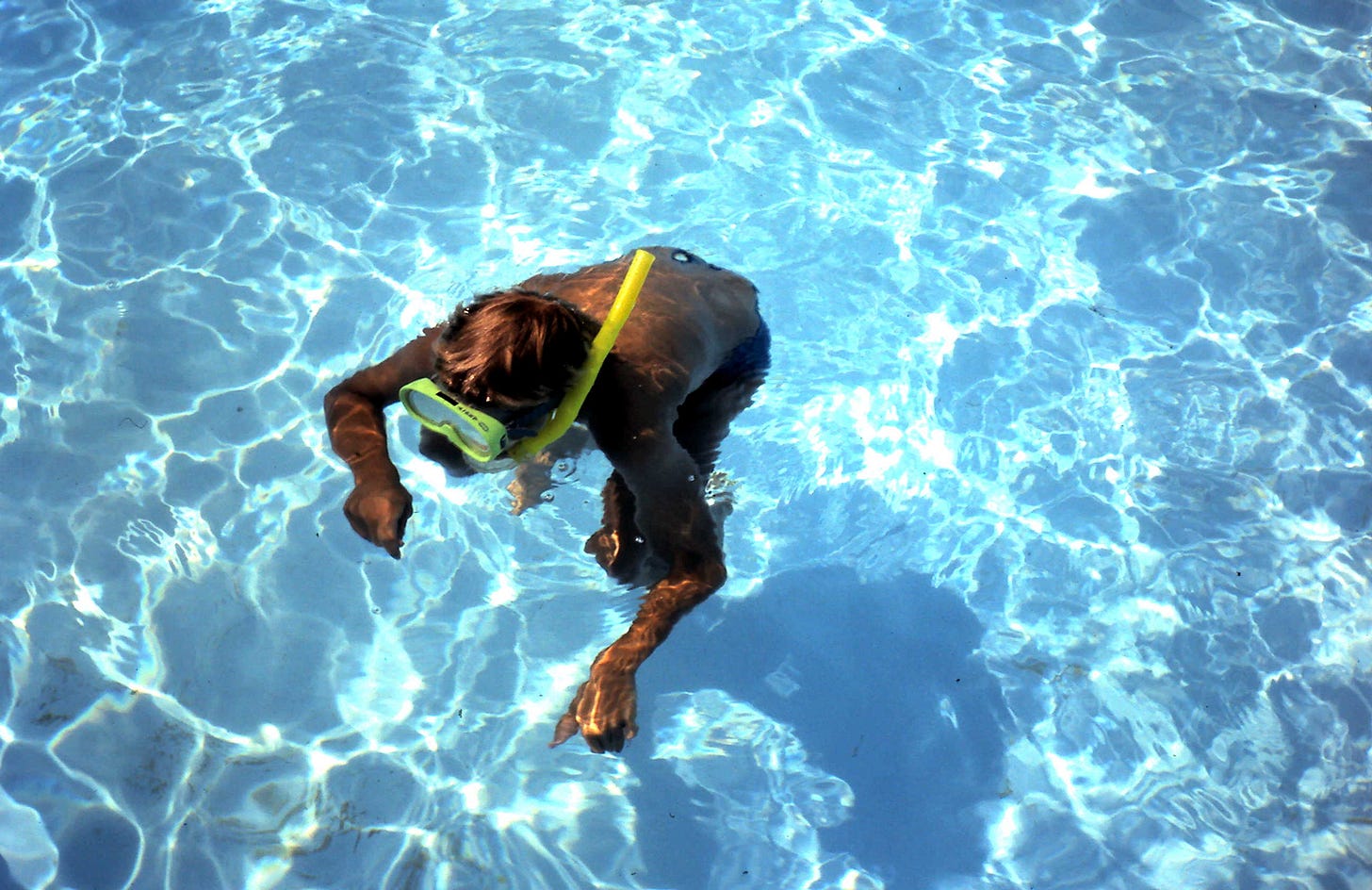Self Portrait (1970)
Is that all this is? A kiss-off to the Folkslingers and Rock’n’Rollers who didn’t get the message after Nashville Skyline? Maybe, but humour me for a moment…
Happy Friday!
And welcome to edition 288 (isn’t that a lot!). For those of you who are new around these parts, my name is David Charles and I’m a UK-based writer, bike botherer and outdoor instructor.
I’ve spent far too long writing today’s post: a 1,500 word review of Bob Dylan’s 1970 monstrosity Self Portrait, illustrated with photographs from my childhood for no obvious reason.
NB: I wrote this piece for my other newsletter, Every Dylan Album, to which you can herewith subscribe. I might drop more reviews into this newsletter over the coming year, but definitely not all of them.
Self Portrait (1970)
Recorded over the space of a year and bloated with old-time cover versions and obscure live takes of the hits, Self Portrait must have come as a shock to fans of both Dylan the Folkslinger and Dylan the Rock’n’roller.
In Rolling Stone magazine, Greil Marcus welcomed the 24-track LP into the world with the famous words:
What is this shit?!
Let’s give it a listen, shall we?
Above: The author, ten years old, on a family holiday in Dartmoor (April, 1993)
A Note On Random Chance
If you’re wondering why I’m starting my review series with Dylan’s most vilified album, it’s because I used a spreadsheet to select the order at random.
If you’re wondering why I’ve just shown you a photograph of me aged ten, well… Dylan has released 39 studio albums, which is one for every year that I’ve existed.
So, for no obvious reason at all, I’ve decided to pair every Dylan review with a corresponding photo from my forgotten past. Hence, for Dylan’s tenth album, a photo of myself aged ten (see above).
Anyway, back to the music.
The Music
It is, by and large, shit. So let’s get a shovel and start digging. Can we unearth an album worth the listening?
Of the 24 tracks, I say that we can immediately dispense with the three live recordings.
Putting aside their variable quality (Like A Rolling Stone: flat-out terrible; She Belongs To Me: passably interesting; Quinn The Eskimo: entertainingly rompish), their place is not on a studio album, but on a greatest hits compilation (which is exactly where Quinn is plonked a year later).
So we’re down to 21 tracks.
Of those, 16 are covers, leaving just five Dylan originals. It’d be unfair to completely dismiss the cover versions, but I’ll set them aside for a moment.
The Five Originals
Actually, three of the five are instrumentals and it’s hard to say quite how much songwriting Dylan himself did. Certainly the most successful, Woogie Boogie, relies heavily on the talent of the blues band soloists. Dylan never learned the sax.
There are, apparently, some interesting musical goings on in All The Tired Horses, but mostly I hear the twiddlings of a guy who’s just discovered a few new gadgets in the recording studio. Hard to listen to, even by accident.
Wigwam summons the atmosphere of Dylan’s consistent preoccupations: Cowboys and Indians, Mexico and the Mariachi. For that reason, I give it a free pass.
That leaves just two Dylan originals with words. Not exactly a prodigious output for the voice of several generations. In fact, now we come to listen, we realise that Minstrel Boy was plucked from the famous Basement Tapes that Dylan recorded with The Band back in 1967.
That leaves Living The Blues as the last remaining Dylan original on Self Portrait.
It’s not bad.
The 16 Covers
Where do we start with this mess? First, let’s split them into traditional and contemporary.
9 Contemporary Covers
There are nine songs on Self Portrait that were written (or re-popularised) in the 1960s or 1950s by people other than Dylan.
Given that the median Dylan album contains only ten tracks in total, why ram this Self Portrait with an albumful of songs written by his contemporaries?
There seem to be two reasons for these covers:
To Show Off His Crooning Voice
The crooning category contains I Forgot More Than You’ll Ever Know, Let It Be Me, Copper Kettle, Blue Moon and Take Me As I Am.
Vocally, these songs sound like the inspiration for Nashville Skyline, which Dylan had released the previous year. But, stripped of Dylan’s Skyline smile, they come across as utterly humourless.
Perhaps with the exclusion of Let It Be Me, we can dispense with the whole lot without fear of recriminations.
To Have Fun
Into this category we put Early Mornin’ Rain, Gotta Travel On and The Boxer (yes, the Simon & Garfunkel song).
I can’t think of any reason why these cover versions should exist, other than Dylan had fun singing them. No harm in that. Except that at least one of the covers is simply horrible. I’ll leave it to you to work out which.
The Everly Brothers’ Take A Message To Mary seems to fall into both categories, which is FINE.
A brief mention is due to Thirsty Boots, a splendid Eric Anderson song that Dylan recorded in a bombastic rendition for Self Portrait, but chose to exclude from the album. More on that sort of shenanigans in a bit.
7 (or 4) (or 5) Traditional Covers
Here, Dylan is on more solid ground. So solid, in fact, that he steals the songwriting credit in the liner notes.
Ever since Bob Dylan (his first album), Bob Dylan (the singer) has been a jukebox of the American folk and blues tradition.
His special talent has always been one of interpretation and, often, the appropriation of melody for his own lyrics. See Blowing In The Wind, The Times They Are A’Changin’, etc..
It’s what he’s best at and, when it works, it’s genius. When it doesn’t work, it’s In Search Of Little Sadie.
The Little Sadies / Sadists
In Search Of Little Sadie is purportedly the sound of Dylan trying to find an interpretation of the traditional folk song Little Sadie. I say ‘purportedly’ because the musical chaos has been carefully written and practised. This is not a rehearsal. This is — what else? — a joke.
I’m sure it’s very clever, very funny and very Dylan, but it’s not particularly fine listening.
Two songs later, we get the actual Little Sadie. Jaunty. But even here, mystifyingly, the producer cuts late and we hear the sound of a tape machine clicking off and a guitar clanging.
In some ways, these two songs are the beating heart of Self Portrait. This album was written and produced to sound like a band warming up. The sound of Dylan behind the shades: an honest self portrait.
The question is: why be honest? We’ll never know for sure, but we all have guilty pleasures (Gangsta Rap, Bryan Adams) and — guess what? — Dylan does too. Just no one ever dreamed his would be this embarrassing.
Trad Today Gone Tomorrow
Okay, so we’ll cut the Little Sadies, but what about the other trad songs?
It’s a mixed bag.
The album begins and ends with two almost identical versions of the traditional blues song Alberta — one in double time, one in triple time.
Alberta is a great song and both performances crackle — but why did Dylan think we needed both takes? Perhaps, taking his own lyrics literally, he really was ‘going through all these things twice’.
Days of ‘49, credited to American folklorists Lomax, Lomax and Warner, is another triumph, driven on by the menacing drum kick and the rolling warmth of the piano.
It Hurts Me Too is insipidly unnecessary. Even if Self Portrait wasn’t already overlong — 74 minutes, really?! — It Hurts Me Too would still be unnecessary.
Thanks to the 2013 Bootleg Series release of Another Self Portrait, we know that Dylan recorded at least four superior trad songs that were ultimately cut from the album:
Pretty Saro
Railroad Bill
This Evening So Soon
House Carpenter
In fairness, no accurate self portrait of Dylan would be complete without leaving a few of the best songs off the album. Blind Willie McTell, Abandoned Love, Seven Days, Seven Curses, Series of Dreams, Red River Shore — it’s a classic Dylan move.
The Disappearing Act Of Belle Isle
That leaves one final song that did make the cut: Dylan’s take on Belle Isle. Marc Bolan was a huge fan:
Belle Isle brought to my memory all the moments of tenderness I’ve ever felt for another human being, and that, within the superficial landscape of pop music, is a great thing indeed.
Bolan’s right that Belle Isle is a beautiful song, even if, personally, I feel like the campfire guitar clashes with the strings as the song reaches a climax. With its soaring strings and matinée crooning, Belle Isle doesn’t even sound like ‘Dylan’. He’s not there.
On which note, it’s time to return to that famous Rolling Stone review:
There is a curious move toward self-effacement; Dylan removing himself from a position from which he is asked to exercise power in the arena.
Is that all this is? A kiss-off to the Folkslingers and Rock’n’Rollers who didn’t get the message after Nashville Skyline?
Maybe, but humour me for a moment…
Is Self Portrait a buried classic?
If I were compiling a ten-track Dylan album from the bloated ruins of Self Portrait and Another Self Portrait, this is what I’d come up with:
Alberta #2
Days of ‘49
Early Mornin’ Rain
Let It Be Me (or Take A Message To Mary if you prefer)
Pretty Saro
Woogie Boogie (Wigwam if you need to cool off)
Belle Isle
Railroad Bill
Thirsty Boots
Living The Blues
And, blow me, if that isn’t a great album. A 32-minute Self Portrait of which anyone would be proud. Even my ten-year-old self, face down in a swimming pool in France:
If you enjoyed that little read, there’ll be more on an almost weekly basis over at Every Dylan Album. Next up: Christmas in the Heart.
100 Days of Adventure
🟢🟢🟢🟢🟢🟢🟢🟢🟢🟢🟢🟢🟢🟢🟢🟢🟢🟢🟢🟢🟢🟢🟢🟢🟢
🟢🟢🟢🟢🟢🟢🟢🟢🟢🟢🟢🟢🟢🟢🟢🟢🟢🟢🟢🟢🟢🟢🟢🟢🟢
🟢🟢🟢🟢🟢🟢🟢🟢🟢🟢🟢🟢🟢🟢🟢🟢🟢🟢🟢🟢🟢🟢🟢🟢🟢
🟢🟢🟢⚪⚪⚪⚪⚪⚪⚪⚪⚪⚪⚪⚪⚪⚪⚪⚪⚪⚪⚪⚪⚪⚪
I should be spending this evening preparing for the Ultimate Beach Nationals this weekend, but they’ve been cancelled because of an atrocious weather forecast. As I look out over becalmed seas and a rosy sunset, I wonder if they made the wrong call.
I’ll see you out on the water.
Big love,
dc:






